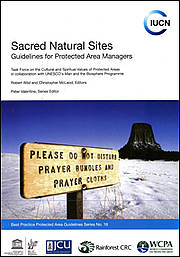IUCN and UNESCO publish guidelines on sacred natural sites in protected areas
07 October 2008 | International news release
Thousands of sacred natural sites are in jeopardy around the world despite the fact that many lie within formal Protected Areas.
At the IUCN World Conservation Congress in Barcelona, Spain, IUCN and UNESCO launch the latest in the Best Practice Guidelines Series on Protected Area management. The new guidelines are called Sacred Natural Sites – Guidelines for Protected Area Managers. The 100-page volume focuses on improving protection of sacred natural sites within and near Protected Areas.
“IUCN has become a key player in the effort to protect sacred sites and holy lands of the planet,” says Gonzalo Oviedo, IUCN Senior Adviser on Social Policy. “We run projects in the field with custodians of sacred places, we support them at the policy level, we advocate for their recognition and support and we promote better understanding of their values.
Around the world there is growing interest in, and recognition of the importance of, sacred natural sites as critical elements to both biological and cultural preservation, especially in light of the accelerating loss of biocultural diversity as an unintended by-product of globalization. These new Guidelines summarize experience to date in recognizing, planning and managing sacred natural sites in a variety of Protected Areas. The Guidelines will be used to share experience with protected area managers and their colleagues around the world who are concerned about and interested in protecting sacred natural sites.
The new publication includes 44 guidelines and 16 case studies from around the world. While focusing primarily on the sacred places of indigenous communities, the guidelines are also relevant for the sacred sites of mainstream faiths.
“From the ground up, working from place to place, we are building bridges with custodians of sacred lands of indigenous and traditional peoples as well as of religious and monastic communities,” says Gonzalo Oviedo, IUCN Senior Adviser on Social Policy. “Alliances between many such groups and conservation are based on strong common values and a shared commitment for the planet.”
There are now 108,000 protected areas worldwide encompassing 11.75 million square miles, an area greater than the African continent, but the definition and practice of protection is not uniform. Indigenous peoples are sometimes excluded or forcibly removed from their traditional territories and separated from sacred natural sites they have cared for over many generations.






